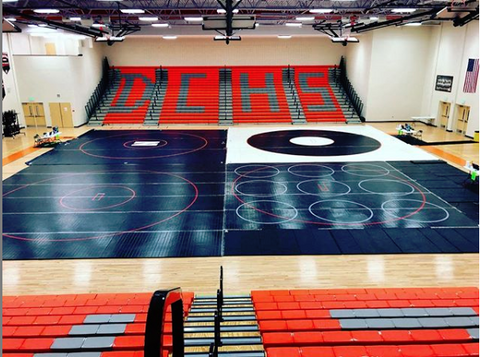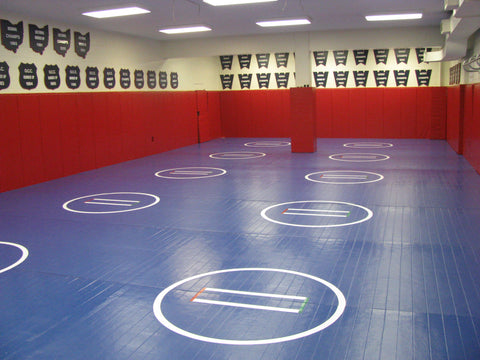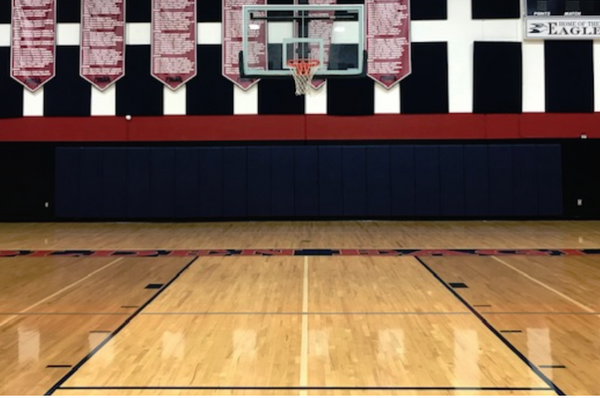Wrestling Regulations
NCAA: National Collegiate Athletic Association

"The entire competition circle and surrounding matted area shall be the same thickness, which shall not be more than 4 inches nor less than the thickness of a mat that has the shock-absorbing qualities of a 2-inch-thick hair-felt mat. For the 2017-18 season, it is recommended the entire competition circle and surrounding matted area meet the most current ASTM Specification Standard for wrestling mats. By the 2018-19 season, all wrestling mats shall comply with the ASTM Specification Standard. All mats that are in sections shall be secured together." - Page 9
"There shall be placed in the center of the mat two 1-inch down position starting lines. The lines shall be 3 feet long and 10 inches apart. Two 1-inch neutral starting position lines shall close the ends of the down position starting lines. One of the two neutral starting lines shall be green and located closest to the home team, and the other shall be red and located closest to the visiting team." - Page 9
"No obstruction such as tables, bleachers, competitor seating or walls shall be placed closer than 5 feet from the edge of the competition circle. It is recommended, whenever possible, that all obstructions be placed not closer than 8 feet from the edge of the competition circle. When two mats are side-by-side, there shall be at least 5 feet of matted area between the two competition circles." - Page 10
The American Society for Testing and Materials
"Nonprofit organization that develops and publishes technical standards, covering the procedures for testing and classification of materials of every sort"
"This standard is used to measure and describe the response of materials, products, or assemblies to heat and flame under controlled conditions."
"Designed to issue a basis to determine one aspect of the fire exposure behavior of a floor-covering system installed in a building."

"Establishes the physical and performance requirements for qualifying construction designs of competition wrestling mats used in U.S. collegiate or high school style (Type I), and international free style (Type II) wrestling. The mats shall be tested and conform accordingly to tensile strength, shock absorption, and thickness requirements."
"Specifies impact attenuation performance requirements for playground surfaces and surfacing materials and provides a means of determining impact attenuation performance using a test method that simulates the impact of a child’s head with the surface."
"This guide is intended to provide guidance for the selection of test methods that are applicable to determining fire-test-response characteristics of upholstered furniture items contained within a detention cell."
"The intended use of this specification is for the qualification of construction designs and comparison of wall padding."
"sets guidelines for labels and instructions to manufacturers that manufacture wrestling mats."
"Measures the impact attenuation of surface systems and materials, specifically the peak impact acceleration (“impact shock”) produced under prescribed impact conditions."
International Code Council
"Association dedicated to developing model codes and standards used in the design, build and compliance process to construct safe, sustainable, affordable and resilient structures."
Guidelines addressing the design and installation of innovative materials that provides safeguards from hazards associated with public health and safety.
National Fire Protection Association
" This test is also known as the “room corner” test. Determines the contribution of interior finish materials to room fire growth during specified fire exposure conditions. This method is intended for the evaluation of the flammability characteristics of wall and ceiling interior finish, other than textile wall coverings, where such materials constitute the exposed interior surfaces of buildings.”
"Establishes test methods to assess the propagation of flame of textiles and films under specified fire test conditions."
Proposition 65: State of California
WARNING: Attention California residents: This product contains chemicals known to the State of California to cause cancer and birth defects or other reproductive harm.
Next →
← Previous















